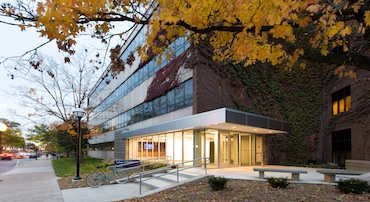Dr. Eddie Boyd & Dr. Leslie Shimp Collaborate on New Book

Together, Eddie L. Boyd, MS, PharmD, and Dr. Leslie Shimp, PharmD, MS, have recently released a book entitled African American Home Remedies-A Practical Guide With Usage and Application Data. The book is filled with the results of years of research compiled within the African American community.
The information on home remedy use of African Americans in the book is based on two studies conducted by Dr. Boyd, Dr. Shimp, and other colleagues at U-M.
(1) The study funded by Administration on Aging created a compendium of home remedies used by elderly African Americans and explored the reasons that motivated these individuals to seek alternatives or complementary therapies in addition to convention medical care.
(2) The second study was an analysis of nationally representative data gathered by the National Survey of Black Americans (James Jackson, Principal investigator, ISR) and examined the relationship between socioeconomic characteristics and use of one remedies/herbal medicines.
The second portion of the book provides monographs on the home remedies identified by the two studies. The monographs include a picture of the plants/herbs used as home remedies. All the information in the monographs is evidenced based and referenced.
Much of the book is based on Dr. Boyd’s personal experience. He is the twelfth child in family of thirteen children living in Canton Mississippi in the 1940-1950’s. His family had absolutely no money to go to doctors and no health insurance. Whenever he and his siblings were ill or as his mother would say, “she wanted to keep them from catching something”, she used home remedies or herbs for their treatment. Approximately one-half of the home remedies and herbs discussed in this publication were used by the Boyd family. Some of the most common uses of remedies by the family were for coughs, colds and stomach problems in children.
Dr. Boyd was associate professor of pharmacy in the College of Pharmacy and clinical pharmacist at the University Hospitals and retired from active faculty status on August 31, 2003. Dr. Boyd received his PharmD from the University of California, San Francisco, in 1970. He joined the University of Michigan faculty as an assistant professor in 1971 and was promoted to associate professor in 1977. He earned his MS degree in clinical research design and statistical analysis from the University of Michigan in 1989 and served as interim head of the clinical sciences faculty from 1999-2000 and associate chair for the Department of Clinical Sciences from 2000-01. Dr. Boyd played an important role in the development of the clinical pharmacy program, and he was instrumental in establishing new clinical practice sites for ambulatory care students. He was a leader in the college's conversion from a BS degree program to the PharmD professional degree program, which is now the national standard.
Dr. Boyd was particularly interested in the use of alternative medicines among African Americans. His research and other projects related to self-care led to the creation of a popular, required course on nonprescription drug therapeutics for pharmacy students. His latest research efforts focus on the use of oxyetazoline as a lower-risk alternative to epinephrine when used to control gum bleeding during oral surgery. Dr. Boyd was an active member of the Michigan Board of Pharmacy for many years and was influential in resolving pharmacy law issues within Michigan. He used this experience to teach pharmacy law and to serve as a resource to community pharmacy practitioners. He was recently honored with a Career Service Award by the Association of Black Professionals, Administrators, Faculty, and Staff at the University. Dr. Boyd was named associate professor emeritus of pharmacy by the Regents of the University of Michigan.
"When my mother was using home remedies to treat my health related problems during my childhood, I never dreamed that I would spend any time writing about them and discussing them biweekly later in life," adds Dr. Boyd.
Dr. Shimp currently serves as Professor of Pharmacy at the College of Pharmacy, Assistant Professor of Pharmacy in the Department of Family Medicine at the Medical School, and Clinical Pharmacist at the University of Michigan Health System (UMHS). Dr. Shimp has been a faculty member at the U-M College of Pharmacy for over 38 years. She received her BS'74 and PharmD'76 degrees from U-M College of Pharmacy, as well as her MS in Public Health. Dr. Shimp completed a Pharmacy residency at Buffalo General Hospital from 1975-76, and is a strong advocate for the inclusion of complementary and alternative medicine (CAM) information in the Therapeutics courses at the College of Pharmacy. She worked as a clinical pharmacist with the Integrative Medicine Clinic at U-M for two years prior to beginning a Medical Home practice as part of the Ambulatory Care Clinical Pharmacy Initiative. Dr. Shimp has worked to ensure the revision of Therapeutics course information to include common and/or evidence-based CAM therapies so that students are better informed on this topic as practicing pharmacists. Dr. Shimp continues to teach in the Therapeutics course sequence and also presents on the topic of CAM therapies in the elective Medicinal Chemistry course 505. For the last 2 years, Dr. Shimp has been involved in the creation of a Medicinal Plants Garden at U-M Matthaei Botanical Gardens. The garden will open this year and currently there is an exhibit at the U-M Museum of Art (UMMA) on Medicinal Plants – Medicinal Plants and Gardens: The Matthaei Botanical Gardens & Nichols Arboretum.
Dr. Shimp's expertise includes women's health issues, health care issues of the elderly, and CAM therapy, including folk and herbal remedies.
"Many patients are interested in and use CAM therapies along with conventional medications. It is important that pharmacist are knowledgeable about common CAM therapies and know where to get evidence-based information they can use to educate their patients and to make therapeutic recommendations on the use of CAM therapies," states Dr. Shimp.
Copies of the book are available on Amazon and Barnes & Noble.



